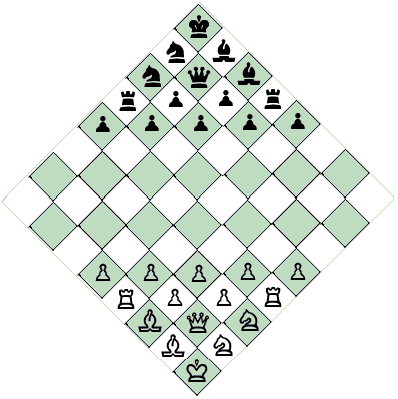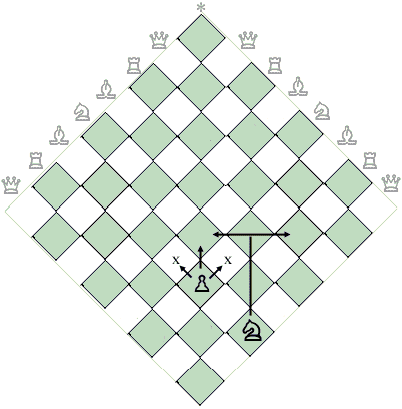Diagonal Chess
Description
The board is set up as pictured below. Players should sit at opposing corners of the board, so that the board is situated diagonally between them. Forward movement is diagonal.
+---+---+---+---+---+---+---+---+ - | |...| |.p.| r |.n.| n |.k.| 8 +---+---+---+---+---+---+---+---+ - |...| |...| |.p.| p |.q.| b | 7 +---+---+---+---+---+---+---+---+ - | |...| |...| |.p.| p |.b.| 6 +---+---+---+---+---+---+---+---+ - |.P.| |...| |...| |.p.| r | 5 +---+---+---+---+---+---+---+---+ - | R |.P.| |...| |...| |.p.| 4 +---+---+---+---+---+---+---+---+ - |.B.| P |.P.| |...| |...| | 3 +---+---+---+---+---+---+---+---+ - | B |.Q.| P |.P.| |...| |...| 2 +---+---+---+---+---+---+---+---+ - |.K.| N |.N.| R |.P.| |...| | 1 +---+---+---+---+---+---+---+---+ - a b c d e f g h -Initial board layout (text) (visualize it tilted 45 degrees) |
 Initial board layout (graphical) |
Rules
- The rules of normal chess apply unless otherwise noted.
- Pawns move forward diagonally, and capture horizontally and vertically (see diagram below).
- Pawns do not have an initial two square move.
- Castling is not allowed.
- Knights move as in normal chess, except diagonally (see diagram below).
- Pawn promotion. A white pawn that reaches a8, g8, h7 or h1 may promote to a Queen (or less). A white pawn that reaches b8, f8, h6 or h2 may promote to a Rook (or less). A white pawn that reaches c8, e8, h5 or h3 may promote to a Bishop or Knight. A white pawn that reaches d8 or h4 may only promote to a Knight. If a white pawn reaches h8 (on a legal move) then white wins the game. Similar rules apply for black. See the following diagram. Note, a player may still win by checkmating.
Q R B N B R Q * - +---+---+---+---+---+---+---+---+ - | |...| $ |...| |...| |.k.| 8 +---+---+---+---+---+---+---+---+ - |...| |...| |...| N |...| | Q 7 +---+---+---+---+---+---+---+---+ - | |...| $ |...| |...| |...| R 6 +---+---+---+---+---+---+---+---+ - |...| |...| |...| |...| | B 5 +---+---+---+---+---+---+---+---+ - | |...| |...| $ |...| $ |...| N 4 +---+---+---+---+---+---+---+---+ - |...| |...| x |.*.| |...| | B 3 +---+---+---+-|-/---+---+---+---+ - | |...| |.P-- x |...| |...| R 2 +---+---+---+---+---+---+---+---+ - |.K.| |...| |...| |...| | Q 1 +---+---+---+---+---+---+---+---+ - a b c d e f g h -The white pawn on d2 may capture on d3 or e2, or may move to e3. The white knight on f7 may move to any of the $ squares. Promotion squares for white are indicated on edge of board. |

Pawn and Knight moves / Promotion squares |
Notes
- A design limitation of this game was to be able to use a normal chess baord and pieces, with no extra equipment.
- A Knight is limited to moving to either light or dark squares. This decreases the value of the Knight.
- Both Knight promotion squares are the same color. Not a big problem, but aesthetically unpleasing.
- Only seven pawns used. Would be nice to find a use for the eighth pawn.
Written by David Howe.
WWW page created: April 24, 1997.